
Probability Calculator
Probability Calculator, step by step calculation
Probability plays a fundamental role in various fields, from statistics and finance to engineering and healthcare. Calculating probabilities accurately allows us to make informed decisions, assess risks, and predict outcomes. With the advent of technology, the Probability Calculator has become an invaluable tool for simplifying complex probability calculations. In this article, we delve into the significance of a Probability Calculator, its applications across different domains, and how it empowers individuals and businesses to gain insights and improve decision-making.
Probability Calculation in Risk and Statistical Analysis With Financial Planning
Probability calculations help in assessing risks and making informed decisions under uncertainty. By quantifying the likelihood of various outcomes, individuals and businesses can evaluate potential risks and plan accordingly. Also Probability calculations form the basis of statistical analysis, allowing researchers to draw meaningful conclusions from data. They provide insights into the likelihood of certain events occurring and help in estimating population parameters.
On the other hand Probability calculations are crucial in financial planning, risk management, and investment decision-making. They assist in evaluating investment opportunities, estimating returns, and quantifying potential losses.
How Does a Probability Calculator Work?
A Probability Calculator employs mathematical formulas and algorithms to compute probabilities based on given inputs. It considers factors such as sample size, event outcomes, and probability distributions to provide accurate probability estimates. The calculator generates results in the form of percentages or ratios, enabling users to interpret and apply them in their decision-making processes.
How can you operate this tool?
When you see this tool, you will find that it has a very easy interface.
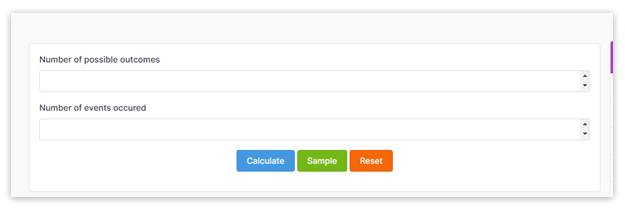
You will see 2 empty boxes. One is for Number of possible outcomes and the other is for Number of events occurred.
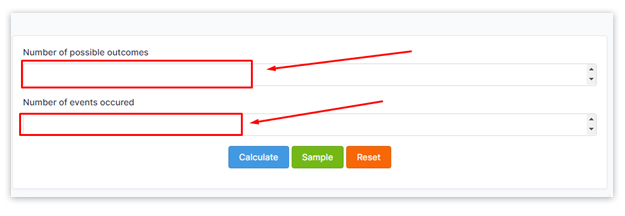
You can also find 3 buttons below named calculate, sample and reset.
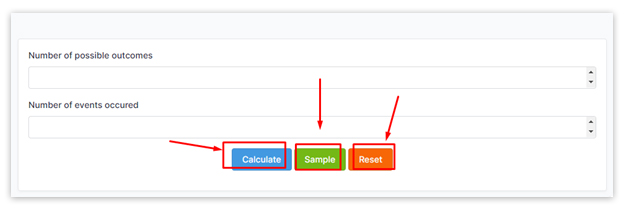
If you press the sample button then our system will automatically generate 2 numbers. Then you can press calculate for trail purpose.
Now enter your possible outcomes in the blank field and number of events in the event box.
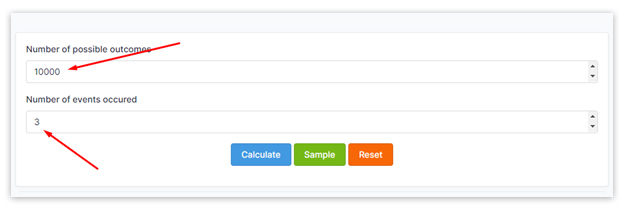
Now you are one step ahead of the result. Press the calculate button. You will see the result below.
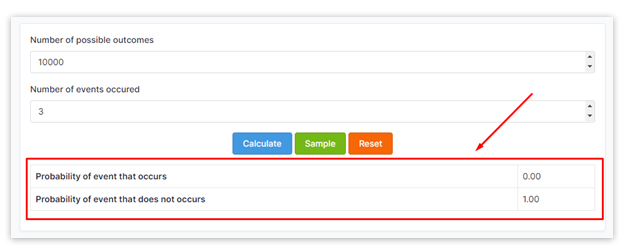
With this way you can easily calculate.
In Data Analysis and Quality Control
Probability Calculators are extensively used in data analysis to determine the likelihood of specific outcomes or events. They aid in statistical inference, hypothesis testing, and predictive modelling. Probability calculations are crucial in quality control processes, where they help identify and address deviations from desired quality standards. They aid in assessing product defects, process variations, and reliability analysis.
Work With Healthcare and Medicine
Probability Calculators assist in medical diagnosis, treatment decision-making, and predicting patient outcomes. They enable healthcare professionals to assess the probability of disease occurrence, evaluate treatment efficacy, and estimate prognosis.
It's time saving activities
Accurate Probability Estimation: Probability Calculators provide precise and reliable probability estimates, enhancing the accuracy of decision-making processes. They eliminate manual errors and save time in complex probability calculations.
Visualization and Interpretation: Probability Calculators often provide graphical representations, such as probability distributions and charts, making it easier to interpret and visualize probability outcomes. This aids in better understanding and communication of results.
Efficiency and Flexibility: Probability Calculators automate complex probability calculations, saving time and effort. They offer flexibility in adjusting input parameters and allow for scenario analysis, enabling users to assess the impact of different variables on probability outcomes.
Educational Tool: Probability Calculators serve as educational tools for learning about probability theory and its applications. They help individuals grasp concepts, perform calculations, and gain a deeper understanding of probability principles.
Conclusion
The Probability Calculator is a powerful tool that simplifies complex probability calculations and empowers individuals and businesses to make informed decisions. By accurately quantifying probabilities, it enhances risk assessment, improves statistical analysis, and aids in financial planning. Embrace the convenience and accuracy of a Probability Calculator to unlock valuable insights, gain a competitive edge, and make data-driven decisions in various domains.











